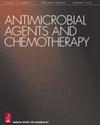重氮环辛烷β-内酰胺酶抑制剂的作用?
IF 4.1
2区 医学
Q2 MICROBIOLOGY
Antimicrobial Agents and Chemotherapy
Pub Date : 2025-03-05
Epub Date: 2025-01-28
DOI:10.1128/aac.01543-24
引用次数: 0
摘要
对34例多药耐药(MDR)铜绿假单胞菌感染治疗后出现头孢唑氮-他唑巴坦(tolz -taz)耐药性的患者的基线和暴露后分离物进行配对分析,以确定头孢唑氮与替代β-内酰胺酶抑制剂是否可以恢复敏感性。基线TOL-TAZ MIC中位数为2 mg/L;88%的暴露后分离株携带新的ampC突变。ceftolozane-tazobactam、ceftolozane-avibactam (AVI)、ceftolozane-relebactam (REL)和ceftolozane-durlobactam (DUR)的MIC中位数较基线分别增加32、24、16和6倍。ceftolozane-durlobactam活性在特定ampC突变中明显增强。本文章由计算机程序翻译,如有差异,请以英文原文为准。
Restoring ceftolozane susceptibility: a role for diazabicyclooctane β-lactamase inhibitors?
Paired baseline and post-exposure isolates from 34 patients who developed ceftolozane-tazobactam (TOL-TAZ) resistance following treatment of multidrug-resistant (MDR) Pseudomonas aeruginosa infections were analyzed to determine if ceftolozane with an alternative β-lactamase inhibitor could restore susceptibility. The median baseline TOL-TAZ MIC was 2 mg/L; 88% of post-exposure isolates harbored new ampC mutations. Median MIC fold-increase from baseline was 32-, 24-, 16-, and 6-fold for ceftolozane-tazobactam, ceftolozane-avibactam (AVI), ceftolozane-relebactam (REL), and ceftolozane-durlobactam (DUR), respectively. Enhanced ceftolozane-durlobactam activity was evident in specific ampC mutations.
求助全文
通过发布文献求助,成功后即可免费获取论文全文。
去求助
来源期刊
CiteScore
10.00
自引率
8.20%
发文量
762
审稿时长
3 months
期刊介绍:
Antimicrobial Agents and Chemotherapy (AAC) features interdisciplinary studies that build our understanding of the underlying mechanisms and therapeutic applications of antimicrobial and antiparasitic agents and chemotherapy.

 求助内容:
求助内容: 应助结果提醒方式:
应助结果提醒方式:


